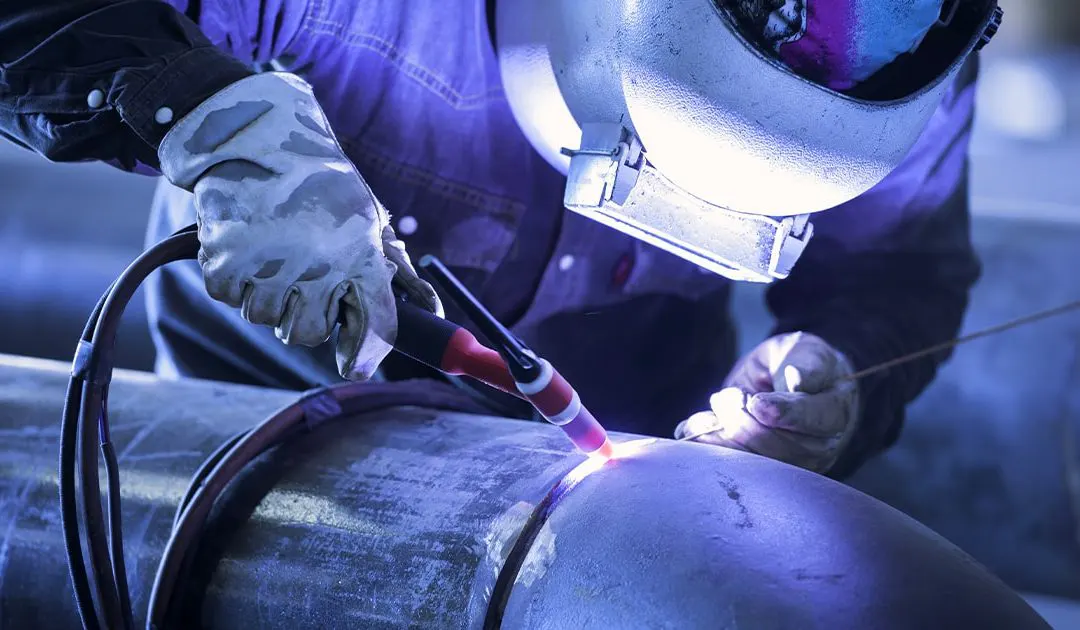How to start with this process?
TIG (Tungsten Inert Gas) welding is a welding process that uses a tungsten electrode and an inert gas (usually argon or argon-helium mixture) to shield the weld area and melt it. It is used to weld materials such as aluminum, stainless steel and copper, and is often used to produce high quality, precision joints. Here is how the TIG welding process works in detail: 1. Preparation of the weld area: Before starting to weld, it is important to thoroughly clean the weld area and protect it from contamination. This can be done using a grinder. 2. Setting up the welding equipment: to weld with the TIG process, you will need a TIG welding machine, a tungsten electrode, an inert gas (usually argon or argon-helium mixture), a welding mask and welding gloves. Make sure all equipment is in place and in good condition before you start welding. 3. Tungsten electrode placement: The tungsten electrode is inserted into the electrode holder of the welding unit. It must be properly sharpened and kept at the right distance from the welding area (usually between 3 and 4 mm). 4. Lighting the arc: To light the arc, you must press the foot pedal or the trigger of the TIG torch. This sends an electric current through the tungsten electrode and creates an electric arc between the electrode and the workpiece. 5. Adding the gas shield: Once the arc is lit, inert gas is added to the weld zone to protect the arc and the weld zone from oxygen and moisture in the air. The inert gas also keeps the weld area clean and prevents contamination of the weld area. 6. Melt the base metal: by maintaining the arc and adding base metal to the molten bath.
Shielded Metal Arc Welding (SMAW)

Gas Torch Welding (Oxy fuel welding)
This is a welding process in which the heat source is an electric arc between the workpiece and a non-fusible (refractory) electrode within a protective atmosphere flowing from the torch nozzle. The role of the gas is to protect the molten metal, the tungsten electrode (W) and the filler metal (which is why it is left until the gas fades under the torch). The nature of the gas (argon or helium) will also influence the energy of the arc, the shape and depth of penetration (the voltages observed with helium are higher than with argon. This results in better penetration), the surface appearance of the bead (better with helium). Hydrogen (H) and nitrogen (N) can be used in a mixture with argon (Ar) or helium (He): gas action in welding the shielding gas will have an impact not only on the geometry of the bead (better penetration because higher arc voltage with H) but also on the chemistry and metallurgical structure of the bead (H being strongly reducing, it reduces traces of oxides on the beads / N favours the formation of austenitic structures). The settings of the pre-gas and post-gas phases during TIG welding are important for oxidation and shrinkage defects. The refractory electrode consists of tungsten (W) or tungsten alloy. The choice is made according to the emissivity required in relation to the arc environment (an environment that is too hot for an alloyed electrode may cause the electrode to disintegrate). This electrode must be trimmed when it is too polluted, when it comes into contact with the molten metal or the filler metal or when the tip is damaged (disintegrated due to the temperature). This process can be used with or without filler metal (142). This process is rather slow with a low deposition rate, the polarity is called direct (electrode at the negative pole of the generator). The intensity is adjusted on a TIG station, the arc voltage being a function of the torch height and the gas used. The torches can be air or water cooled and the nozzles adapted for the gas flow to generate a protective atmosphere.
Greyish bead (on stainless steel) : Poor gas protection (right side / reverse side) Concave bead : not enough filler metal. Gutter : chamfer too tight, current too strong - may also be related to lack of filler metal. Uneven penetration : Uneven feed rates, stability of the torch, uneven chamfer (grinding preparation...) Lack of penetration : Current too low, root clearance (joint preparation, pinching during welding), energy too low (speed too high, gas atmosphere, electrode size), unmelted spot. Lack of fusion / bonding (rare) : Current too low, root clearance and chamfer (access to bottom of joint), position and type of joint (heat input / heat output) Tungsten inclusion (W) : Poorly sized electrode, poorly chosen electrode composition, electrode in contact with the melt (not detectable by visual inspection) Oxide inclusion : Filler metal enriched with Si ( TIG in automatic ), the silicates are found in the skin of the bead and must be ground off. Most often on aluminium in manual TIG (alumina layer) Shrinkage : Arc fade time too short, S and P impurities, shrinkage on solidification too high (clamping of parts, lack of liquid metal) Blowout : Poor degreasing of the edges to be welded, poor gas protection (nozzle or torch leakage, end of cylinder), fade time too short, leakage in the cooling water circuit, steel elements that volatilize or steel that is not calmed.Special case: closure of a reinforcing saddle or a fur without vent.
